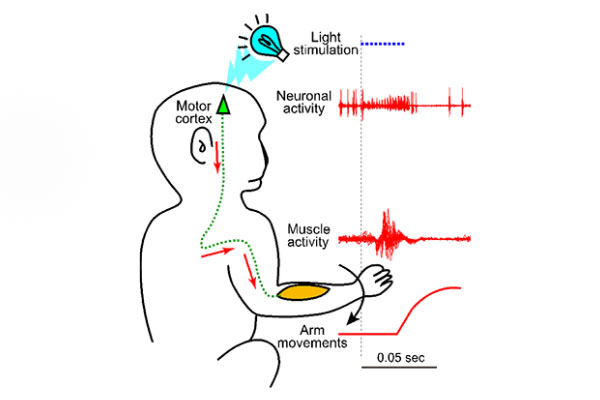Optogenetics is a new method that uses light to control neurons that have been genetically modified to be light sensitive. It has revolutionized neuromodulation, allowing researchers to activate or inhibit neuronal cells within living animals; thus, controlling their behaviors.
Using this method, researchers from the National Institute for Physiological Sciences and Tohoku University have succeeded in inducing arm movements in Japanese macaque monkeys and will publish their results in Nature Communications on June 29.
Until now, most successful optogenetic studies have been carried out on rodents. Barring a few studies targeting eye movements, trials seeking to modify behaviors in monkeys have failed.
The research team, led by Professor Atsushi Nambu and Professor Hajime Mushiake, first developed an adeno-associated viral vector - a tool that delivers genetic materials into cells. The team then injected the viral vector, which expressed a light-sensitive protein called channelrhodopsin, into the arm region of the motor cortex where electrical stimulation induces arm movements.
The team also developed an optrode that can record neuronal activity while applying light and electrical stimulation separately. The optrode was inserted into the motor cortex, and light stimulation was applied.

A schematic drawing of the experimental setup. Researchers used a blue laser light to illuminate neuronal cells in the monkey's motor cortex containing channelrhodopsin, successfully inducing neuronal activity, muscle activity, and arm movements. ⒸTohoku University
Light stimulation through the optrode effectively activated neuronal cells expressing channelrhodopsin, and induced muscle activity and clear arm movements, which are comparable to those induced by electrical stimulation through the same optrode.
Professor Mushiake, from Tohoku University, noted that the study has opened the door to optogenetic studies in non-human primates and clinical applications in human patients. "This is one of the few successfully optogenetic studies to be carried out in Monkeys." He adds, "The next phase of our research is the therapeutic application of light-induced brain activation to various neural diseases. We are currently working on improving the efficiency of light-induced activation in collaboration with medical engineering."
- Publication Details:
Title: Forelimb Movements Evoked by Optogenetic Stimulation of the Macaque Motor Cortex
Authors: Hidenori Watanabe, Hiromi Sano, Satomi Chiken, Kenta Kobayashi, Yuko Fukata, Masaki Fukata, Hajime Mushiake, Atsushi Nambu
Journal: Nature Communications
DOI:10.1038/s41467-020-16883-5
Contact:
Hajime Mushiake
Tohoku University School of Medicine
Tel: +81-22-717-8073
Email: hmushiak med.tohoku.ac.jp
med.tohoku.ac.jp


